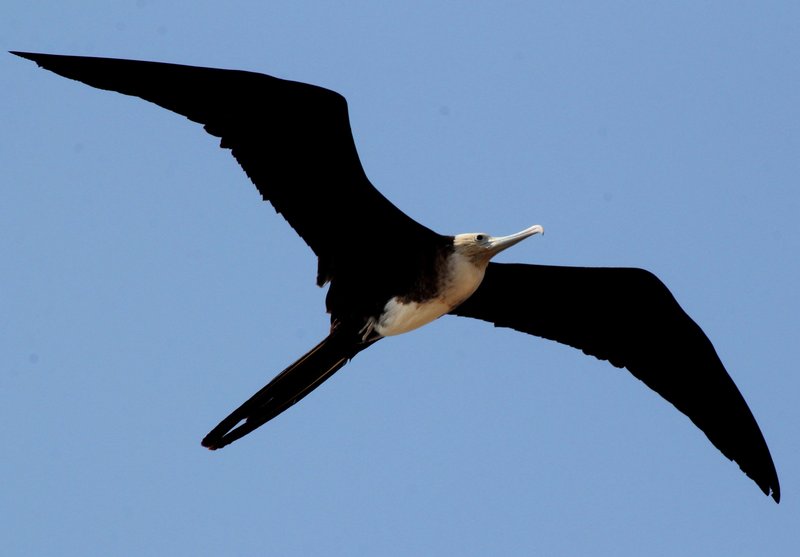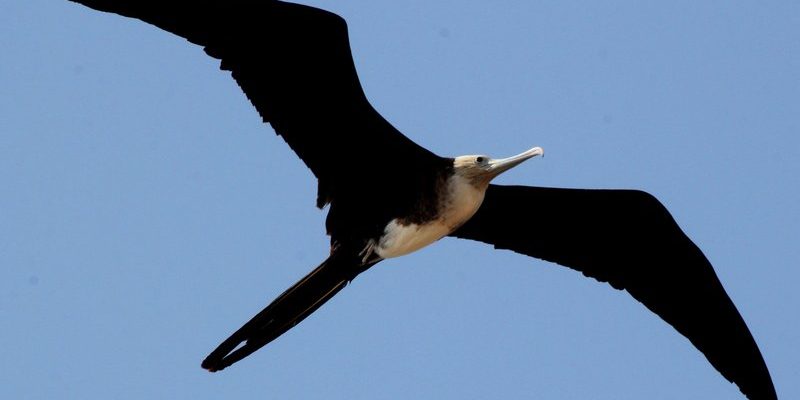
Imagine a bird so majestic that it seems to own the sky—this is the Frigatebird. With its long wings and a striking silhouette, the frigatebird is truly a remarkable sight. Found mostly in tropical and subtropical regions, these birds are often seen soaring high above the ocean, their wide wingspans enabling them to glide effortlessly for hours without flapping. They are not just beautiful; they play vital roles in their ecosystems.
Frigatebirds are unique in many ways. Did you know that they are the only birds that cannot land on water? Instead, they rely on their strong ascents and gliding skills to catch the wind currents. This ability allows them to stay airborne for long periods, sometimes reaching altitudes of up to 10,000 feet! This remarkable adaptation is essential for hunting and foraging for food.
But it’s not just their flying skills that are fascinating. Male frigatebirds are known for their striking red throat pouches, which they inflate during the breeding season to attract females. This display is as much about survival as it is about seduction, showcasing their health and fitness.
Physical Characteristics
Frigatebirds are easily recognized by their striking appearance. They have a large body, long wings that can span up to 8 feet (2.5 meters), and a deeply forked tail. Their feathers are predominantly black, with an iridescent sheen that shimmers in the sunlight. Males are particularly notable for their vibrant red throat pouch, contrasting starkly with their dark plumage. This pouch serves not just as a mating signal but also as a mechanism for regulating body temperature.
Female frigatebirds exhibit a more subtle beauty, with a white breast that complements their darker wings. They are slightly smaller than males, which helps them adapt to their nurturing role during breeding. Their beaks are long and curved, perfectly designed for catching fish and squid while in flight.
It’s interesting to note that frigatebirds have no waterproof feathers like many seabirds. This means they can’t dive into the water to catch their food. Instead, they rely on their impressive aerial skills to snatch fish from the surface using their beaks. This adaptation has made them highly skilled hunters.
Habitat and Range
Frigatebirds thrive in tropical and subtropical environments, predominantly near coastal areas. You’ll find them nesting on remote islands in the Caribbean, the Galapagos, and the Indian and Pacific Oceans. Their preferred locations often have minimal vegetation, allowing them to take off and land easily, which is essential since they can’t swim.
These birds are highly migratory and can cover vast distances in search of food. For instance, they have been recorded flying over 1,500 miles in search of meals, feeding on fish and marine invertebrates. Some species, like the magnificent frigatebird, are known to follow ocean currents and be active during the day while searching for food, often roosting in trees or on cliffs during the night.
Their choice of habitat is crucial not only for feeding but also for breeding. They prefer locations that are away from human disturbance, as they are quite sensitive to changes in their environment. This need for isolation makes conservation efforts essential in protecting their nesting grounds.
Diet and Feeding Habits
When it comes to food, frigatebirds are expert foragers. Their diet primarily consists of fish and squid, but they also scavenge from other seabirds. They have developed a unique hunting technique: they often follow other birds to steal their catches. This behavior helps them conserve energy while ensuring a steady food supply.
Frigatebirds can catch fish from the water’s surface without getting their feathers wet, a fascinating skill that sets them apart from many other seabirds. They use their keen eyesight to spot potential meals from high above, swooping down to grab them with their sharp beaks. It’s a delicate dance of grace and precision.
Another interesting aspect of their feeding habits is their ability to go long periods without eating. Frigatebirds have adapted to survive during times when food is scarce, relying on stored fat reserves to sustain themselves until they can find their next meal. This ability helps them thrive in environments where food resources are unpredictable.
Breeding and Nesting Behavior
Frigatebirds are known for their distinct mating rituals, which often take place on remote islands or cliffs. During the breeding season, males display their inflated red pouches to attract females. This is not just a simple courtship display; it’s a competition for the attention of potential mates, showcasing vitality and stamina.
Once a female is attracted, the pair will mate and create a nest together. Their nests are usually made of twigs and placed in trees, providing some degree of safety and shelter from predators. Unlike many birds, frigatebirds have low reproductive rates, often laying only one egg per breeding cycle. Incubation lasts about two months, and both parents take turns caring for the egg and chick.
After hatching, the chick will rely on its parents for food, and they continue to care for it long after it leaves the nest. This extended parental care is crucial for the chick’s survival, as it helps them learn crucial skills like foraging and social interaction.
Conservation Status
The conservation status of frigatebirds varies by species, but many face threats due to habitat loss, pollution, and climate change. As ocean temperatures rise and food sources become scarcer, these magnificent birds are at risk. Conservationists are working hard to protect their habitats and breeding sites, which are crucial for their survival.
Additionally, frigatebirds are vulnerable to human activities such as fishing and plastic pollution. They often ingest plastic debris mistaken for food, leading to serious health issues. Efforts to reduce marine pollution and promote sustainable fishing practices are essential to ensuring the future of these resilient birds.
Organizations around the world are committed to raising awareness and implementing strategies to protect frigatebirds. Engaging local communities in conservation efforts is a key aspect of these initiatives, fostering a sense of stewardship for their local ecosystems.
Interesting Facts About Frigatebirds
| Size: | Wingspan of up to 8 feet (2.5 meters) |
| Habitat: | Tropical and subtropical coastal areas |
| Diet: | Fish, squid, and scavenged meals |
| Lifespan: | Up to 20 years in the wild |
| Breeding: | One egg per season |
FAQ
How do frigatebirds catch their food?
Frigatebirds are known for their remarkable ability to snatch fish from the ocean’s surface without diving. They soar high above the water, using their keen eyesight to spot fish. Once they spot a potential meal, they swoop down quickly, grabbing the fish with their sharp beaks. This method allows them to stay dry and conserve energy while hunting.
Are frigatebirds social birds?
Yes, frigatebirds are quite social, especially during the breeding season. They tend to gather in large colonies for nesting and display activities. Even during feeding, you can see them flying in groups, taking advantage of the skills of others to locate food. Their social behaviors play an essential role in their survival.
What is the biggest threat to frigatebirds?
The biggest threat to frigatebirds comes from habitat loss and environmental changes caused by climate change. As sea levels rise and temperatures increase, their nesting sites and food sources are threatened. Additionally, pollution, particularly plastic waste in the ocean, poses a significant risk as frigatebirds inadvertently consume harmful materials.
How long do frigatebirds live?
Frigatebirds can live up to 20 years in the wild, although many factors, including environmental conditions and predation, can influence their lifespan. Their long lives are often attributed to their high adaptability and the skills they develop over time, especially when it comes to hunting and breeding.
Do frigatebirds migrate?
Yes, frigatebirds are migratory birds. They often travel vast distances in search of food, following ocean currents and seasonal changes. Their excellent flying abilities allow them to cover these distances efficiently, making them quite adaptable to different environments.
Can frigatebirds swim?
No, frigatebirds cannot swim. Unlike many other seabirds, their feathers are not waterproof, meaning they cannot land on water like ducks or gulls. Instead, they rely on their impressive flying abilities to catch fish from the surface, sometimes spending long periods in the air without resting.
How do frigatebirds care for their young?
Frigatebirds provide extensive care for their young. After a chick hatches, both parents take turns feeding it regurgitated food, helping the chick grow strong. They continue to care for the chick long after it leaves the nest, teaching it crucial survival skills like foraging and socializing with other birds.
What do the different species of frigatebirds look like?
Frigatebirds come in several species, the most notable being the magnificent frigatebird and the great frigatebird. Males typically have the distinctive red throat pouch, while females have a more subdued coloring. Each species has unique traits, but all exhibit the same elongated wings and forked tail that help them glide gracefully.
What role do frigatebirds play in their ecosystem?
Frigatebirds play a vital role in their ecosystem by being both predators and scavengers. Their feeding habits help maintain fish populations and they contribute to nutrient cycling in their habitats. As they travel long distances, they also help spread seeds and other organic materials, making them essential to the health of their environments.
Can you keep a frigatebird as a pet?
Keeping a frigatebird as a pet is not advisable or legal in most places. They are wild animals that require vast territories, specific diets, and environmental conditions that are challenging to replicate in a home setting. Instead, it’s best to admire and respect these incredible birds in their natural habitats.
How do frigatebirds find their mates?
Mating season brings interesting rituals for frigatebirds. Males attract females by inflating their red throat pouches and performing elaborate displays of strength and health. These rituals help females choose the fittest males to ensure the best chances for their offspring’s survival.
Are frigatebirds endangered?
While some species of frigatebirds are classified as near threatened or vulnerable, conservation efforts are ongoing to protect their habitats and reduce threats from pollution and climate change. Organizations worldwide are working to ensure these spectacular birds continue to thrive in their natural environments.

